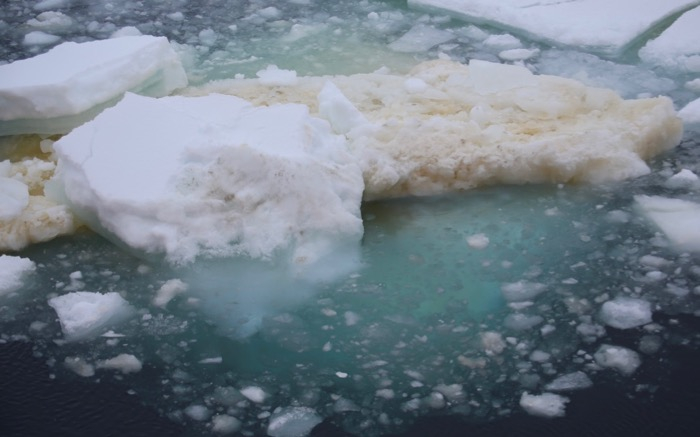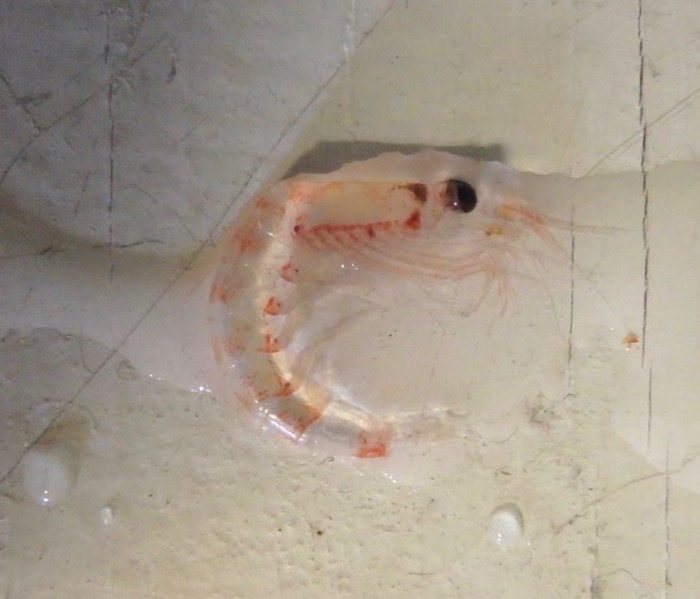A View to a Krill
Barry and Sheldon, the two Electronics Techs onboard, manage a diverse array of equipment for the science team and the boat crew. They can fix things that break and build things that don't already exist from the materials they have onboard. On this trip, they were asked to construct a rig that could be attached to the megacore sediment sampler that would carry a GoPro camera, a light, and enough batteries to power both so that we could capture video of the cores deploying on the seafloor. While Barry and Sheldon have adjusted the angle of the camera so that it points more at the megacore itself, the first few set-ups created amazing footage of the organisms that usually remain anonymously hidden in the depths.
A recent megacore video revealed an active population of **krill* - or tiny, shrimp-like creatures that are abundant in Antarctic waters. So abundant, in fact, that scientists estimate there is more biomass of Antarctic krill on Earth than there is any other species - that means the total weight of Antarctic krill is greater than the weight of all the African elephants on Earth. It also means the total weight of all the krill is greater than the weight of all the humans. That is a lot of krill. The population estimates were so high in the 2017 Offline Wikipedia (300 to 400 trillion individuals) that I had to seek out other sources to confirm because it seemed implausible. No one has a precise number, but I saw multiple sites that mentioned that there can be as many as 30,000 individuals in a cubic meter of water, a density that could definitely yield a total population of more than 300 trillion. The Antarctic Australian Division maintains a krill tank, and you can watch it online here. Their abundance matches their essential role in the Antarctic ecosystem. Half of all those trillions of krill are eaten by whales, penguins, fish, and other organisms every year. The krill themselves often eat the algae that grows on the underside of the ice in Antarctic waters. I frequently notice that yellowish-green hue created by the algae on the bottom of the icebergs floating by - I think it makes the ice look dirty in my pictures, but that algae is invaluable to the food web here.

As the krill population changes, it can trickle down through the food web economy. The dramatic decrease in whale numbers perpetrated by the whaling industry in the early 1900's led to a subsequent population boom in Adélie penguins because no whales meant more krill for the penguins. And more recently, some scientists think that a decrease in the extent of ice coverage due to warmer temperatures has triggered a reduction in the amount of algae available for krill to eat, which could have broad and dramatic consequences for the entire Antarctic ecosystem. (Note: there are other factors at play here - whale populations have also increased, which is likely contributing to a reduction in krill numbers as well.) There is also a small but growing fishing industry focused on krill, which can be used to produce fish food and vitamin supplements high in omega-3 fatty acids.

Krill are very messy and inefficient feeders, and they often spit out clumps of algae (literally called spit balls) made up of thousands of algal cells all stuck together. They also produce fecal strings (this time there is no funny-sounding official term for fecal strings, but I am sure someone out there can think of one - doo-doo tassels?) that still contain significant amounts of undigested carbon. Both are heavy and sink very fast into the abyss. This carbon rain (a term that I just now coined) acts as a carbon sink: exporting large quantities of carbon out of the biosphere and trapping it in spit balls and fecal strings on the seafloor. Because their population is so large, the rate of krill feeding behavior can actually have an impact on atmospheric carbon levels. Krill could be fighting for our side in the climate catastrophe, but we still know so little about their population as a whole.


Comments